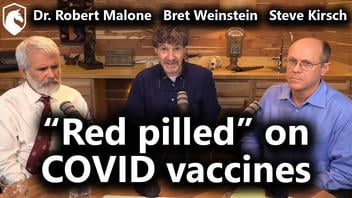STORY UPDATED: check for updates below.

Is this video correct in suggesting there's a "we know" consensus that mRNA vaccines against COVID-19 cause the body to create "very dangerous" toxic proteins? No, that's not true: There's no peer-reviewed medical study proving this assertion has been accepted. The CDC rejects the claim, saying there is no medical evidence to support it.
Part of the claim rests on remarks made on a radio talk show by a veterinary school professor whose university does not endorse his declaration that the spike proteins dangerously spread through patients' organs. Part of the claim relies on a Japanese language document that is not, as the video host claims, proof the spike protein runs free upon injection. Medical experts who have been studying and fighting the pandemic for more than a year have not reported in actively edited science journals that the spike is free-roaming and lethal.
And the final point of the video, that people who suffer adverse reactions won't report them due to social pressure is illogical, given that any person with a computer can report an adverse reaction via the federal government's vaccine safety monitoring system from their couch, whether they are the doctor, patient, family member or friend.
The claims were made in a YouTube video (archived here) published by evolutionary biologist Bret Weinstein's "Dark Horse" podcast on June 13, 2021, titled "Spike protein is very dangerous, it's cytotoxic." The text introduction begins:
... Dr. Robert Malone is the inventor of mRNA Vaccine technology. Mr. Steve Kirsch is a serial entrepreneur who has been researching adverse reactions to COVID vaccines. Bret talks to Robert and Steve about the pandemic, treatment and the COVID vaccines.
Click below to watch the video on YouTube:
Robert Malone's supporters' claim (archived here) that he was intellectually "raped" at the Salk Institute. But the Virginia-based MD/pharmaceutical expert's claim that he invented mRNA vaccine technology is not recognized by independent authors writing about development of the ground-breaking method.
This fact check instead focuses on his claims, with the engineer and evolutionary biologist in the video, about purported lethality of spike proteins.
Spike proteins are the key to the success of the mRNA vaccine. They deliver a kind of biological software that induces patients' cells at the injection site to create the spiky sphere found on the SARS-CoV-2 coronavirus. Recognized as a foreign invader, the spike protein triggers patients' immune systems, building antigens that will then attack the virus if the patient is infected by the virus that causes COVID-19. The vaccine has been found to cause humans to build a very specific antigen to fight the virus.
In the introduction to the podcast episode, Weinstein says, starting at 32 seconds and continuing to about two minutes 44 seconds, there's little doubt guest Steve Kirsch has uncovered a serious problem:
You read this and either something's wrong with you Steve and you've completely misportrayed the data and there's no problem and something's up with you, or if the data is anything like what you present, then the interpretation is quite clear and absolutely startling ... Undoubtedly there are errors. ... What if what he's saying is 50% right it's still alarming. ... Something has gone wrong and we are in danger and we are not behaving rationally.
The video's claims are addressed below with hyperlinks to the relevant time code, which permits readers to immediately hear the claim themselves.
Claim 1. The spike protein is "cytotoxic ... very dangerous"
At five minutes,42 seconds, after telling an anecdote about an acquaintance he says had a heart attack immediately after having the Pfizer mRNA vaccine, video host Weinstein says, "The spike protein itself we now know is very dangerous, it's cytotoxic." His guest, Malone, agrees, saying the Food and Drug Administration (FDA) rebuffed his warnings about the risk "months and months ago." Kirsch, a tech entrepreneur who has built and sold several companies, is also on the set with them.
FDA press officer Abby Capobianco said in a June 23, 2021 email to Lead Stories that there's no support for the claim. She wrote:
There is no scientific data to indicate that the spike protein in mRNA vaccines is toxic or that it lingers at any toxic level in the body after vaccination. As with many other vaccines, COVID-19 vaccines can cause some side effects. Most side effects of vaccines, including COVID-19 vaccines, are usually minor and short-lived. For example, a person may feel soreness at the injection site or experience a mild fever. Serious vaccine reactions are not common, but they can happen. The side effects that people may experience in the first few days following any vaccine is part of the body's immune response to the vaccine. However, it is important to note that side effects following vaccination, or lack of side effects, do not correlate with the effectiveness of a vaccine in an individual.
Lead Stories searched the National Institutes of Health indexes of science journals and found no peer-reviewed studies that would support Weinstein's implication, in word and tone, that there is a consensus view of the spike protein as dangerous.
In a June 22, 2021, email to Lead Stories, a Pfizer spokesman said clinical testing and follow-up with test subjects shows the opposite:
There is no evidence of harmful quantities of toxicity in humans from the Pfizer-BioNTech COVID-19 vaccine. All adverse events are regularly and thoroughly reviewed by Pfizer as well as by regulatory authorities such as the EMA, FDA and CDC. With more than 400 million doses of the Pfizer-BioNTech COVID-19 vaccine administered globally, the benefit risk profile of our vaccine remains positive.
Claim 2. Something has gone terribly wrong with the mRNA vaccine
At two minutes, 52 seconds, Weinstein says, "Something has gone wrong; we are in danger" as a summary of what computer engineer/tech entrepreneur/medical philanthropist Kirsch has written in his blog. Kirsch agrees. He says he grew suspicious of the vaccine when his (unnamed) carpet cleaner told him he got the Pfizer vaccine and had a heart attack "two minutes later" and that the carpet cleaner's wife also had an adverse reaction: a hand tremor she had never before had.
"That is like lightning striking twice in the same place," Kirsch then says. "If it's really a safe vaccine then what I just saw was impossible." Even after a subsequent discussion of the inherent flaws of anecdotal evidence and correct sampling method -- which are bedrock principles of scientific research -- Weinstein says his objection to the vaccine rests in part on finding nearly everyone he has talked to has had a serious adverse reaction to the vaccine.
Medical experts have repeatedly cautioned against assuming correlation proves causation during a vaccine campaign: With hundreds of millions of doses administered, people with pre-existing health conditions are likely to coincidentally have health episodes that are unrelated to the vaccine. More than 317 million doses of COVID vaccine had been administered as of June 21, 2021, the Centers for Disease Control and Prevention reports on its COVID vaccine safety webpage. With what the CDC calls the most thorough vaccine monitoring campaign in history, it has found rare serious adverse reactions: anaphylaxis (similar to the allergic reaction to a bee sting) and thrombosis, a clotting disorder that has hit a handful of women out of the millions vaccinated.
The CDC and FDA's adverse reaction reporting system has not proven (and cannot prove) any of the claims Kirsch makes about vaccines causing deaths and injury. As Lead Stories has reported before, the Vaccine Adverse Event Reporting System does not collect verified reports. It is a messy, likely repetitive list of reports that anyone can make if they own a computer. It serves as a starting point for investigators, raising questions that must be researched and not simply answered from a crowd-sourced list of complaints.
Claim 3: A Canadian veterinary school professor has unearthed proof the spike protein especially lodges in the ovaries
Kirsch, at six minutes, 15 seconds, says his belief is also supported by Byram Bridle, Ontario Veterinary College professor of viral immunology. Kirsch says Bridle demanded, through the equivalent of the Freedom of Information Act, documentation from Japanese regulatory authorities that shows Pfizer has data showing the spike proteins don't stay where they are supposed to and course throughout the body, especially accumulating in the ovaries.
In his June 22, 2021, email to Lead Stories, the Pfizer spokesman said the document, written in Japanese, is a publicly available report on testing of the mRNA vaccine on mice and rats. He said Kirsch's description does not match what the document in question shows:
The document is known as a Common Technical Document which is an internationally recognized standard format for submissions to regulatory authorities. Its use is required for prescription drugs in Japan and elsewhere. The document is a publicly available part of the data submission applied by Pfizer to PMDA for its review.
The document provides a pharmacokinetics overview from early laboratory studies in both mice and rats, assessing how the then investigational COVID-19 vaccine moved through the animals. Simply put, the study showed a benign safety profile with just the expected inflammation associated with an immune response to the vaccine.
In his May 4, 2021, article, organic chemist Derek Lowe, a Ph.D. who works in drug development (not for Pfizer nor Moderna), said the image of spike proteins tumbling through the body ignores the process by which the proteins are made and hosted in the body:
... instead of that being assembled into more infectious viral particles, as would happen in a real coronavirus infection, this protein gets moved up to the surface of the cell, where it stays. That's where it's presented to the immune system, as an abnormal intruding protein on a cell surface. The Spike protein is not released to wander freely through the bloodstream by itself, because it has a transmembrane anchor region that (as the name implies) leaves it stuck. That's how it sits in the virus itself, and it does the same in human cells.
The FDA's documents laying out support for use of the Moderna, Pfizer and Janssen mRNA vaccines to fight the pandemic do not support Bridle's claims that the vaccines sicken patients. Based on tracking the effects on tens of thousands of patients, the FDA found the benefits of the vaccines outweigh potential harms. The Janssen vaccine was briefly put on hold to investigate a half-dozen clotting issues out of millions of patients vaccinated. After developing specific warnings for doctors and patients, the vaccine was released for use again.
Lead Stories reached out to the CDC on June 21 and 22, seeking further response to Weinstein, Kirsch and Malone's claims and will update this fact check, if appropriate, when they reply.
Updates:
-
2021-06-24T02:19:43Z 2021-06-24T02:19:43Z Updated to add FDA rebuttal of the claim.

















